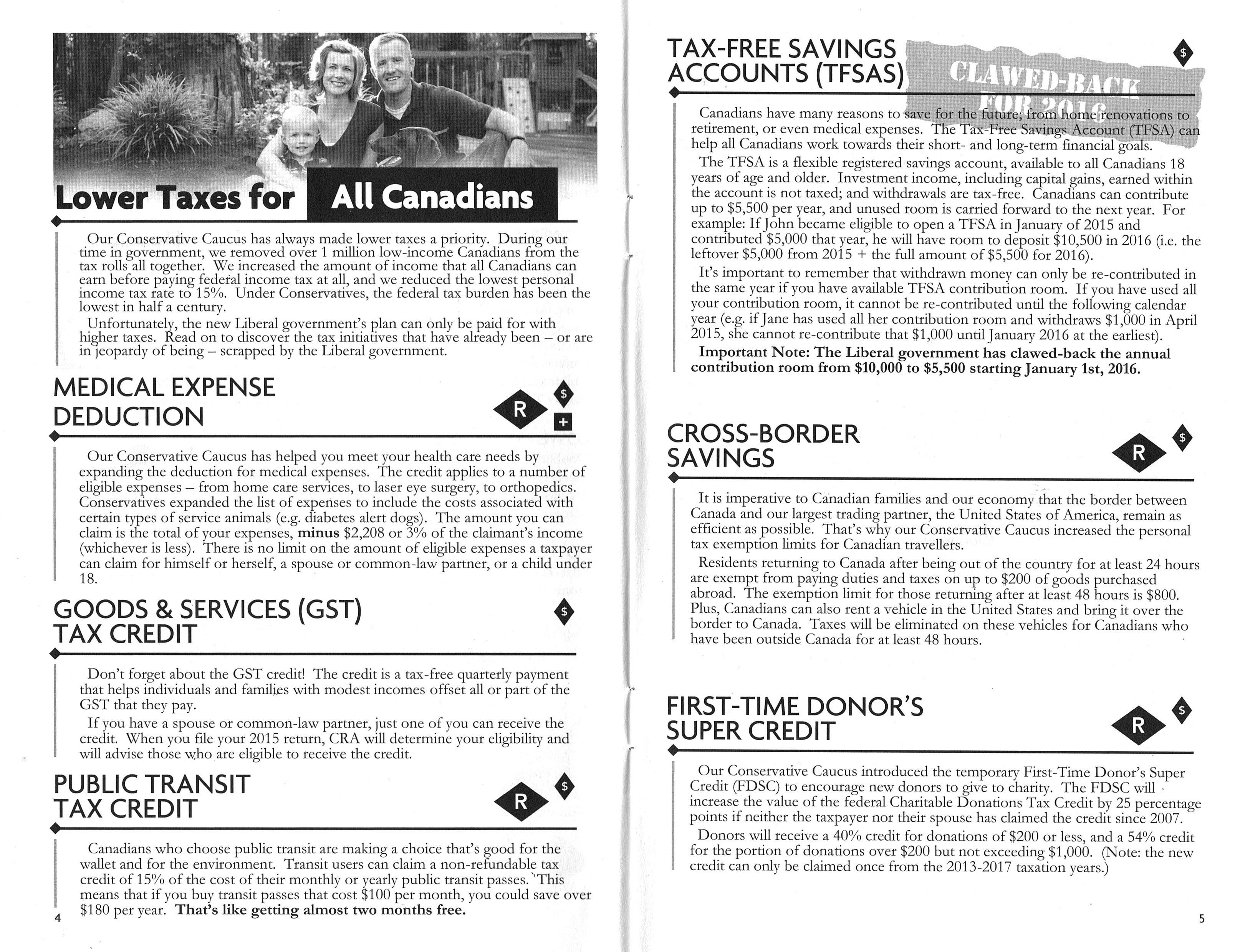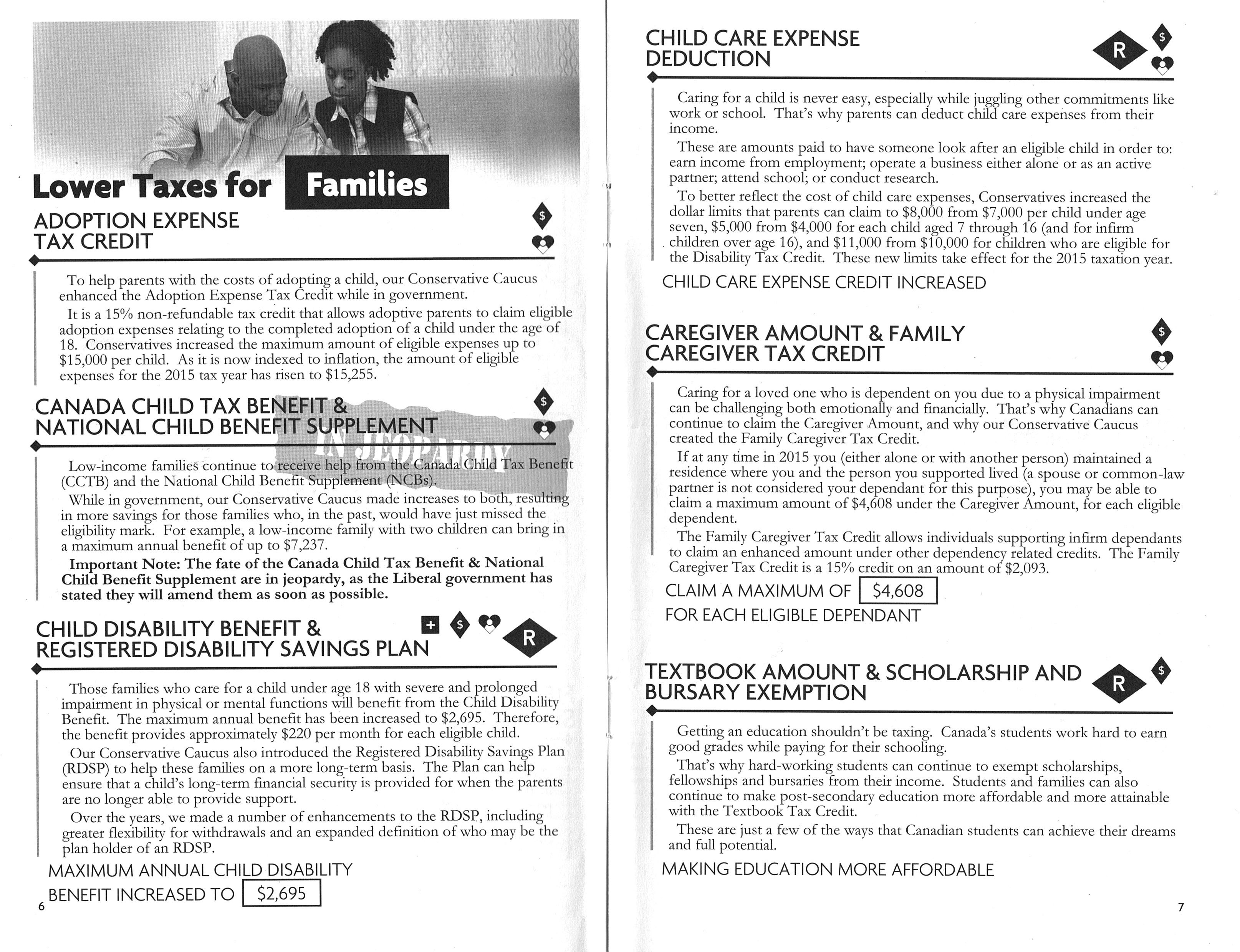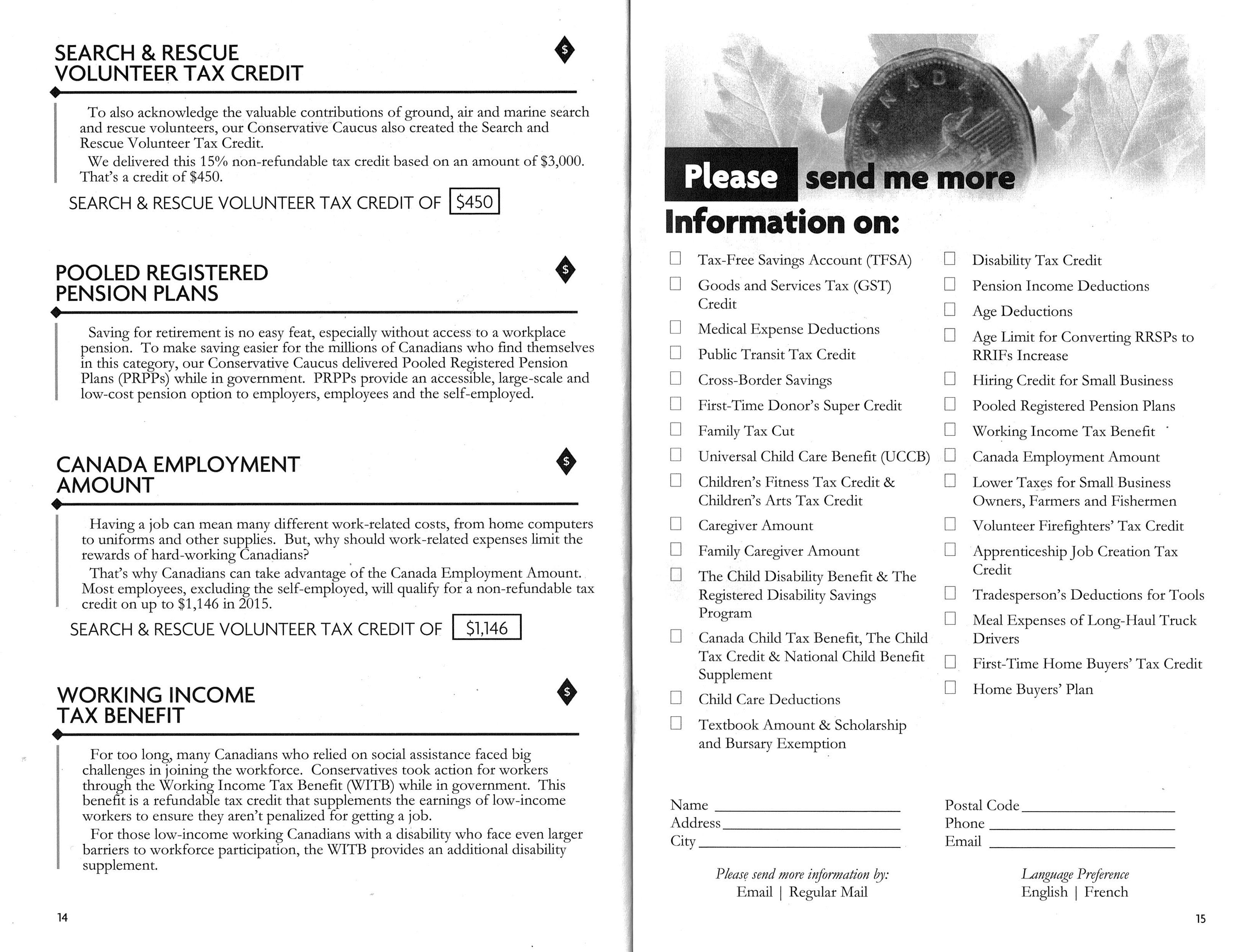![]()
 Type crime is the term author Ellen Lupton uses in her book, Thinking With Type, to describe egregiously bad typography. That description came to mind as I perused the latest fluff mailer from our MP; the so-called “Tax Guide.” So-called because it isn’t a guide: it’s the usual, dreary Conservative whack-a-mole propaganda about how great they were when in power and how evil the Liberals are now.
Type crime is the term author Ellen Lupton uses in her book, Thinking With Type, to describe egregiously bad typography. That description came to mind as I perused the latest fluff mailer from our MP; the so-called “Tax Guide.” So-called because it isn’t a guide: it’s the usual, dreary Conservative whack-a-mole propaganda about how great they were when in power and how evil the Liberals are now.
In fact, if you want actual information, the publication has a final page where you have to send in to get it (or call the Canada Revenue Agency). And unless you’re an accountant, you’ll need more info because this “guide” is pretty vague at its best and has no specific information about filling in your tax form.
Dreary is right: in terms of design, layout and typography, it’s simply awful. I grade it somewhere between the abysmal colour advertising produced by the Town of Collingwood, and the even worse greyscale newsletter. It also has some grammatical errors that a real editor would have caught. *
And why is her information awkwardly centred at the bottom of the front page instead of flush right?

Look at the sample above (pages 4-5). The first thing that strikes the reader is the vertical density of the type. The leading (the space between the lines) is far too tight, leading to a drabness of copy (in some paragraphs, descenders of one line touch the ascenders of the next!).
The thinness of the body typeface, too, adds to the overall greyness.
You should notice that the leading in the stacked headlines is inconsistent, too. And why stacked? There’s plenty of room to spread them across the page. That stacking creates odd, disconnected white spaces that leave the reader’s eye bewildered where to go next. Across to the icons on the right? Down to the words below?
The vertical and horizontal lines around two sides of each section increase the sense of funereal confinement and make each section look like an obituary. And that little diamond on the left end of the horizontal fencing keeps drawing the eye to it.
The background attack-ad graphic at the upper right (“clawed-back for 2016”) impairs clarity and readability. If you look closely, you’ll see that the author used double spaces after end punctuation in sentences, not the proper single space. The paragraph indent is too narrow for the line length, too.
Clawed back doesn’t need a hyphen in either instance. But the benefits were not “clawed back” – they were reduced to former levels. The proper definition of a claw back is, “…money or benefits that are distributed and then taken back as a result of special circumstances.”
And don’t get me started on the run-on sentences, the bureaucratese language and the byzantine descriptions of how our tax system works replete in this work.
By the way, American travellers have an $800 duty-free exemption when returning, compared to Canada’s measly $200. Maybe it’s not something to crow so loudly about.
The headline font for sections appears to be Arial, the body Times New Roman (both over-used and boooooooring….) and the page heads are Agenda bold or perhaps Humanist 521. Why some words are in inverse type is beyond me, nor can I fathom the reason for the inappropriately wide space between some of the inverted words and the other words in the headline.

Look at the icons on the left page, bottom section. A similar mess occurs on p. 8. Why are they scattered around like birds in a bush? Why are they not aligned like most of the other icons? On page 8, they are likewise scattered, but in a different order. The inconsistency is glaringly obvious.
Why does it have both an ampersand and the word “and” in the bottom right headline? Why are home buyers’, children’s, firefighters’ and tradespersons’ all plural possessive, but donor’s is singular possessive?
Not to knock any tax credit, but you will notice at the bottom right under textbook amount it shouts in all-caps “making education more affordable.” Well, that’s not strictly true. A tax credit you receive the year after paying for tuition and textbooks doesn’t actually change the cost of education. Nor is there any reason to suppose a credit will be applied to education as opposed to food, housing, or vehicle costs. It reduces your income tax, assuming you pay any. To truly make education affordable (and accessible), you reduce the up-front costs: lower tuition and fees.
According to the CRA website, you can only claim “…one textbook amount for each month that you qualify for the full-time or the part-time education amounts.” And in typically circuitous fashion, it adds, “You can claim the textbook amount only if you can claim the education amount.” The amounts are 15% of $65/month for full-time or 15% of $20/month for part-time students. For a full-time student, that’s $9.75 a month, or a small coffee at Timmie’s per week. For part-time, it’s $3 a month: a small coffee and maybe a doughnut once a month. That sure takes the sting out of educational expenses, doesn’t it?
Yes, tax credits are lovely and Canadians are grateful that highly paid politicians with their $165,000-plus salaries, their extra sessional allowances, their lifetime pensions and platinum benefits well above what the rest of us will ever get are giving us these meagre crumbs. Please sir, can I have some more? Wow: a pension income credit of $2,000 a year! Why that’s a whopping $5.48 a day. Thanks… of course MPs are paid more than 82 times that…
Columnists in the Globe and Mail called most of these “boutique tax credits”:
These are narrowly focused non-refundable tax credits aimed at the middle class in hopes of currying political favour for the Conservatives come election time. They include the children’s fitness tax credit, public transit credit, tradespersons’ tool deduction, textbook amount for university students, and the home renovation tax credit.
The writers noted that “…non-refundable tax credits provide a bigger benefit to higher income tax filers.” They concluded that savings from cutting these boutique credits “…can be applied to broader tax relief for all taxpayers – thus enhancing the efficiency of the tax system ? or funnelled directly toward deficit reduction.”
Curiously, this publication doesn’t mention once how unbalanced these select high-roller tax credits are or what better options the government should consider.
Nor does this nifty work tell you how first the Liberals then Stephen Harper’s Conservatives lowered the corporate income tax (CIT) rates, thus putting more onus on collecting taxes on regular, working Canadians to pay the costs (but benefitting corporate friends in high places):
…what the Conservatives don’t mention is the corporate tax rate was 22% under the Conservatives in 2007 and also 18% in 2010, both of which are higher than raising the CIT rate from 15% to 17%… according to the non-partisan Parliamentary Budget Officer, cuts to the CIT between 2006 (set at 22.1%) and 2015 (cut to 15%) have cost the federal treasury an estimated $12 billion annually. The result has been a huge loss of public revenues with no meaningful economic gain.
Last spring, before the election, Andy Blatchford wrote a piece for the Canadian Press, headlined, “Tory Tax Relief Gives Least To Middle Earners, Documents Show.” High-income earners got the highest tax relief, not the low-income or middle classes. Surprise, surprise.
The government’s numbers also show while families with kids in the $30,000-$60,000 bracket make up 19 per cent of all beneficiaries, they will only get 11 per cent of the relief… The Finance Department’s own internal breakdown of the distribution of relief shows 68 per cent of the benefits _ about two-thirds _ will go to families that earn as much as $120,000 in 2015.
And what about that huge “first time home buyers’ tax credit… Save up to $750 on qualifying homes.” In BC, the average house price is over $600,000. It’s over $450,000 in Ontario: $750 is about 0.15% of that. Even in New Brunswick, with the lowest average in Canada at $164,000 – it’s only 0.45%. Sure, it’s better than a kick in the teeth, but it’s not even a single mortgage payment anywhere in Canada.
Nowhere in this document is a promise to fight for more, for better credits, for reduced taxes. It’s all about resting on your laurels and whining about the Liberals instead of doing something constructive for Canadians to justify that fat paycheque.
Leitch’s huff-and-puff claims about the middle class and tax credits are really just more smoke and mirrors left over from the Harper Days. Frankly, I would have thought the Tories would scurry as fast as their centipede-like legs could carry them from his legacy, but it seems not. Although Harper’s name doesn’t appear anywhere in the publication, there’s still that stench of him in the ink.
Let me leave you with one last look. This is the “send me more information” form page on the right (p. 14-15):

Note that “Information” is incorrectly capitalized and that “please” is in an inverse box for no apparent reason. The area for respondents to enter information, such as name and address, is ridiculously too small for actual humans to write in. One suspects the party didn’t really want to encourage responses. The check box categories are inappropriately capitalized, too, and only require a cap at the start of each line in most cases.
And did you catch the subhead at the end of the section on the “Canada Employment Amount” on page 14? Yes, it reads incorrectly: “Search & Rescue Volunteer Tax Credit…” Someone should have proofread this before printing it.
As I said, tax cuts and exemptions are wonderful if they benefit the working class Canadians. A lot of these don’t, so there’s no reason to brag.
These are your tax dollars hard at work. Surely our MP could have come up with a better way to spend them than on self-serving pap. Donate the money to a local charity, to an animal shelter, a women’s shelter, a palliative care centre – anything but send out another bit of detritus like this.
~~~~~
* For example, P. 5, under cross-border savings, it says, “It is imperative… that the border… remain as efficient as possible.” Well, aside from the fact that a border is an imaginary line, and cannot by itself be efficient (its guards can be, its crossing processes can be, but the line itself not), the verb should be “remains.” Also on page 5, that grey item that says “clawed-back for 2016” needs to shed the hyphen.
On page 6, it notes, “The fate of the Canada Child Tax Benefit & National Child Benefit Supplement are in jeopardy…” No: the proper verb should be “is” since it refers to fate. But why is there an ampersand in this line, not the word ‘and’?
** Given the unpopularity of Steven Harper and his former Conservative government, you would think that the party would not be playing up his memory. But the publication continually reminds us of that unfortunate time in Canadian history, although cannily not once referring to the former leader by name, just the “Conservative Caucus.” But Canadians aren’t fooled and wish to forget him.
Number of times the word Conservative appears:
Page: Times:
2 2
4 4
5 2
6 4
7 2
8 3
9 3
10 3
11 2
12 3
13 4
14 3
Pages on which an attack on Liberals appears (not including the five banners that warn “in jeopardy” and one warning “clawed-back for 2016″):
Page: Times:
2 1
4 1
5 1
6 1
8 2
9 1
10 1
These are pompously identified with the phrase (in bold) ” Important note.” Everything the Conservatives do seems to be an adversarial position that isn’t complete without a snide attack on someone else.
It is disingenuous to warn us about what the Liberals might do, when the upcoming budget has not been tabled yet. These are simply scare tactics, an old and tired Conservative tactic. But despite Leitch’s dire warning that the “Liberal government has already taken steps to increase taxes…” they have not tabled a budget yet, so until they do, they have taken no action on taxation.
In fact, it seems from media reports that the Liberals are not planning any tax increases. For the 2016 income year, there will be an increase for anyone earning over $200,000. For people with incomes in the $45-$90K range, there will actually be a tax reduction. We won’t know for sure what else until March 22, when the budget comes down.
Closing tax loopholes for the rich would not only be a welcome move for most Canadians, but a financially sound one, too. As economist Toby Sanger pointed out in a recent interview, as much as $16 billion could be saved by those measures.
The largest tax loophole — costing the feds upwards of $12 billion a year — is the fact that capital gains (profits from investments) are only partially included in income taxes. This means investment gains are taxed at half the rate as wage income, Sanger says. Sanger estimates 90 per cent of the benefits of this loophole accrue to the top 10 per cent of earners.
Using calculations from earlier research, the study found the use of tax havens costs Canada about $2 billion annually; stock option deductions cost some $800 million a year; and corporate meal and entertainment deductions cost $460 million.
Had the Conservatives closed these loopholes, they might still be in power.


http://www.thestar.com/news/gta/2016/03/04/dont-know-how-to-do-your-taxes-ask-this-8-year-old.html?utm_medium=twitter&utm_source=twitterfeed
It would seem that if you want REAL tax information, you have to ask an eight-year-old, not your MP…